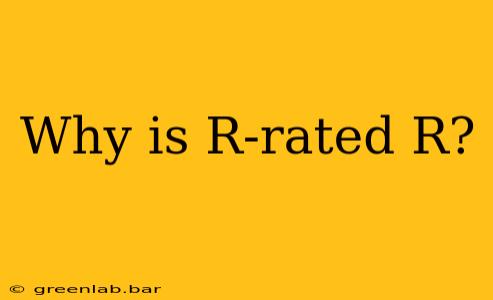The question "Why is R-rated R?" isn't about a single movie; it's about understanding the Motion Picture Association of America (MPAA) film rating system itself. The "R" rating, signifying "Restricted," isn't arbitrarily assigned; it's the result of a specific set of criteria applied to the content of a film. Let's delve into the intricacies of what constitutes an R-rating and why some films earn this designation.
The MPAA Rating System: More Than Just a Letter
The MPAA rating system, established in 1968, aims to provide parents with guidance on the suitability of films for their children. It's a crucial tool for navigating the diverse landscape of cinematic offerings, classifying movies based on their content. The ratings aren't about artistic merit or box office potential; they focus solely on the content's appropriateness for different age groups.
What Makes a Movie R-Rated?
An R-rating indicates that some material may be inappropriate for children under 17. The criteria are broad, encompassing several potential elements, and the presence of any one doesn't automatically guarantee an R-rating. The rating board considers the context, intensity, and pervasiveness of the following:
-
Violence: Graphic depictions of violence, including bloodshed, brutality, and gore, often contribute to an R-rating. The level of realism and the impact of the violence are key factors. While some violence might be acceptable in a PG-13 film, excessive or particularly gruesome violence usually results in an R.
-
Sexual Content: Explicit sexual content, including nudity, sexual activity, and suggestive dialogue, frequently leads to an R-rating. The level of detail and the context in which the content appears are significant considerations.
-
Language: The use of strong language, including frequent use of profanity and offensive terms, can result in an R-rating. The pervasiveness and intensity of the language are key factors.
-
Drug Use: The portrayal of drug use, especially if it's depicted positively or glamorized, often results in an R-rating. The context and intensity of the drug use are important factors to consider.
The Rating Process: A Panel of Parents
The MPAA's rating board comprises parents who review submitted films. They aren't film critics; their job is to evaluate the content based on the established criteria and assign the appropriate rating. The process is confidential, with the board members' identities protected. This system strives for objectivity, though it inevitably faces criticism and debate surrounding specific film ratings.
The Ongoing Debate Surrounding R-Ratings
While the MPAA rating system serves a valuable purpose, its subjectivity and occasional inconsistencies lead to discussions and disagreements. Some argue that the system is too lenient, while others find it overly restrictive. These debates highlight the complex and ever-evolving nature of acceptable content in film. However, the system's core function remains consistent: to guide parents in making informed choices about the movies their children watch.
Conclusion: Understanding the Context
An R-rating isn't a simple judgment of good or bad cinema; it's a reflection of the film's content and its potential impact on younger viewers. Understanding the criteria behind the rating allows for a more nuanced appreciation of why certain movies receive an R-rating, enabling viewers to make informed choices aligned with their preferences and the maturity levels of those in their viewing audience.

